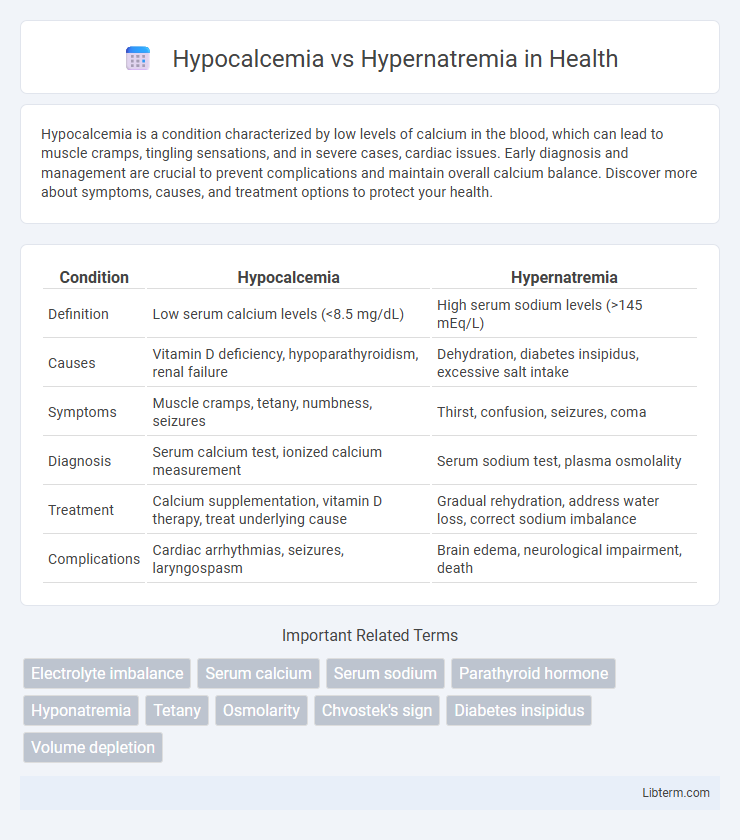Hypocalcemia is a condition characterized by low levels of calcium in the blood, which can lead to muscle cramps, tingling sensations, and in severe cases, cardiac issues. Early diagnosis and management are crucial to prevent complications and maintain overall calcium balance. Discover more about symptoms, causes, and treatment options to protect your health.
Table of Comparison
| Condition | Hypocalcemia | Hypernatremia |
|---|---|---|
| Definition | Low serum calcium levels (<8.5 mg/dL) | High serum sodium levels (>145 mEq/L) |
| Causes | Vitamin D deficiency, hypoparathyroidism, renal failure | Dehydration, diabetes insipidus, excessive salt intake |
| Symptoms | Muscle cramps, tetany, numbness, seizures | Thirst, confusion, seizures, coma |
| Diagnosis | Serum calcium test, ionized calcium measurement | Serum sodium test, plasma osmolality |
| Treatment | Calcium supplementation, vitamin D therapy, treat underlying cause | Gradual rehydration, address water loss, correct sodium imbalance |
| Complications | Cardiac arrhythmias, seizures, laryngospasm | Brain edema, neurological impairment, death |
Understanding Hypocalcemia and Hypernatremia
Hypocalcemia is characterized by abnormally low serum calcium levels, often below 8.5 mg/dL, leading to symptoms such as muscle cramps, tetany, and cardiac arrhythmias. Hypernatremia occurs when serum sodium concentrations exceed 145 mEq/L, resulting in cellular dehydration and neurological disturbances including confusion, seizures, and coma. Recognizing these electrolyte imbalances through clinical evaluation and laboratory testing is essential for prompt and effective management.
Causes of Hypocalcemia
Hypocalcemia primarily results from vitamin D deficiency, chronic kidney disease, and hypoparathyroidism, which disrupt calcium metabolism and reduce serum calcium levels. In contrast, hypernatremia is caused by excessive sodium intake, dehydration, or impaired renal water excretion, leading to elevated serum sodium concentrations. Understanding these distinct etiologies is critical for accurate diagnosis and targeted treatment strategies.
Causes of Hypernatremia
Hypernatremia primarily results from water loss exceeding sodium loss, leading to elevated serum sodium levels above 145 mEq/L. Common causes include dehydration due to inadequate water intake, diabetes insipidus causing excessive free water excretion, and osmotic diuresis triggered by hyperglycemia or mannitol use. Renal dysfunction and excessive sodium administration, such as from hypertonic saline or sodium bicarbonate, also contribute significantly to hypernatremia development.
Key Symptoms of Hypocalcemia
Hypocalcemia presents key symptoms such as muscle cramps, tetany, and paresthesia, often involving the hands and feet. Neurological signs include confusion, irritability, and seizures resulting from low serum calcium levels below 8.5 mg/dL. In contrast, hypernatremia typically causes thirst, lethargy, and seizures due to elevated sodium concentrations above 145 mEq/L.
Key Symptoms of Hypernatremia
Hypernatremia is characterized by symptoms such as intense thirst, dry mucous membranes, and neurological manifestations including confusion, muscle twitching, and seizures due to elevated sodium levels in the blood. In contrast, hypocalcemia presents with muscle cramps, tetany, and paresthesia caused by low calcium concentrations. Recognizing hypernatremia's hallmark symptoms facilitates prompt diagnosis and treatment to prevent severe complications like cerebral edema or coma.
Diagnostic Criteria and Laboratory Findings
Hypocalcemia is diagnosed when serum calcium levels fall below 8.5 mg/dL, often accompanied by elevated parathyroid hormone (PTH) in cases of secondary hypocalcemia, with symptoms like muscle cramps and tetany. Hypernatremia is identified by serum sodium levels exceeding 145 mEq/L, typically resulting from water deficit or excessive sodium intake, and presents with neurological manifestations such as confusion or seizures. Laboratory findings for hypocalcemia include low ionized calcium and possibly low vitamin D, while hypernatremia shows elevated serum osmolality and concentrated urine sodium depending on the underlying cause.
Treatment Options for Hypocalcemia
Treatment options for hypocalcemia primarily include calcium supplementation through oral calcium carbonate or intravenous calcium gluconate in severe cases. Vitamin D analogs such as calcitriol are often administered to enhance calcium absorption from the gastrointestinal tract. Managing underlying causes like hypoparathyroidism or chronic kidney disease is essential for long-term calcium level stabilization.
Treatment Options for Hypernatremia
Treatment options for hypernatremia primarily involve controlled administration of hypotonic fluids such as 5% dextrose in water or half-normal saline to gradually reduce elevated serum sodium levels while preventing cerebral edema. Careful monitoring of serum sodium concentrations and urine output is essential to guide therapy and avoid rapid correction. Addressing underlying causes like dehydration, diabetes insipidus, or excessive sodium intake is critical to preventing recurrence.
Complications and Long-Term Effects
Hypocalcemia, characterized by low calcium levels, can lead to neuromuscular complications like tetany, seizures, and cardiac arrhythmias, with long-term effects including impaired bone metabolism and osteoporosis. Hypernatremia, defined by elevated sodium levels, primarily causes neurological complications such as cerebral edema or intracranial hemorrhage, and chronic hypernatremia may result in persistent cognitive deficits and increased risk of vascular damage. Both electrolyte imbalances require prompt management to prevent severe systemic complications and irreversible organ dysfunction.
Prevention and Management Strategies
Preventing hypocalcemia involves maintaining adequate intake of calcium and vitamin D through diet and supplements, alongside monitoring serum calcium levels in high-risk populations such as post-surgical or renal failure patients. Hypernatremia management centers on gradual correction of sodium levels using hypotonic fluids while addressing underlying causes like dehydration or excessive sodium intake. Both conditions require regular electrolyte monitoring, patient education on symptom recognition, and tailored treatment plans to avoid complications such as cardiac arrhythmias in hypocalcemia and neurological impairments in hypernatremia.
Hypocalcemia Infographic

 libterm.com
libterm.com